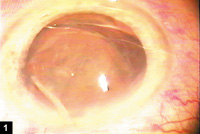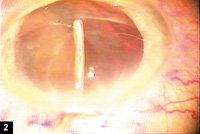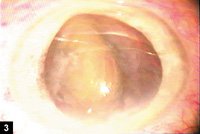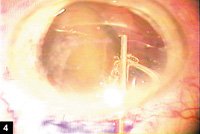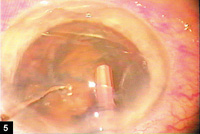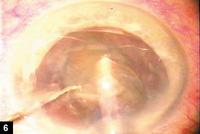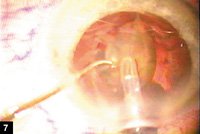Long axis phaco is easy, fast and safe flip technique
Removing the nucleus around its long axis ensures that maximum residual nucleus is between the phaco tip and other structures.
I greatly respect the individuals who have taught us innovative ways to do phacoemulsification. In recent years I have been impressed by surgeons who do some type of luxation of the nucleus out of the bag and then phaco the nucleus. A number of surgeons have led the way including Richard L. Lindstrom, MD (tilt and tumble), R. Bruce Wallace III, MD (hemi-flip), William Maloney, MD (supracapsular) and Robert Kellan, MD (hydro-viscoluxation).
Nuclear “flip”
I have been the most intrigued and impressed by David Brown, MD, and his technique of nuclear “flip.” In his video presentation, his technique was fast and simple. He sent me a videotape of some of his cases and I began doing his method of nucleus removal. Initially, I found the procedure more challenging than it appeared in the videotape but I became proficient. I performed this procedure for about 2.5 years.
There are two concerns that will confront the novice or beginning “flip” surgeon. One is the “forced” luxation of the nucleus out of the capsular bag and the possible stress to the zonules and posterior capsule. The other is removing the nucleus from the posterior to the anterior surface. Working on the posterior or the anterior surface of the lens in the short axis of the lens and under high vacuum settings can cause “drilling through” the nucleus, causing damage to the capsulorrhexis edge, pupil margin or worse yet to the posterior capsule, should surge occur.
Long axis phaco
To address these two potential problems, I developed what I call “long axis” phaco. In this technique the nucleus is luxated to a plane 90° from its physiologic plane in the capsular bag. The equators of the nucleus now point to the ceiling and the floor of the operating room in one axis (the x axis) and toward and away from the surgeon’s chest in the other axis (the z axis). The phaco tip is placed into the nucleus and as the vacuum builds the nucleus is drawn into the tip, causing the nucleus to rotate backwards, like a wheel, into the phaco needle.
The surgeon removes the nu cleus from the equator, which is the longest axis of the lens, in a circumferential fashion. In this technique there is always the maximum amount of residual nucleus in front of the phaco tip, making it less likely that one will be removing or damaging anything other than the intended nuclear material. In my hands this not only makes it safer, but also quick and easy.
Procedure
A corneal incision is located on the axis of the patient’s steep existing cylinder. ProVisc (1% sodium hyaluronate, Alcon) is placed in the anterior chamber and a curvilinear capsulorrhexis is performed. The capsulotomy should be 5 mm or greater. Hydrodissection is performed with a 23-gauge, slightly curved cannula with a 27-gauge opening in the tip. This instrument was designed for this purpose and is available from Rhein Medical. The large external diameter allows manipulation of the nucleus without cutting into it.
Hydrodissection is continued under both the left and right capsule edge extremes until the nucleus begins to luxate out of the bag (figure 1). The cannula can now be used to gently lift the half of the nucleus that is tilting up out of the bag, up to a 90° plane away from its original plane in the bag (figure 2). This is the long axis position (figure 3). Viscoat (chondroitin sulfate, sodium hyaluronate, Alcon) is placed over and on either side of the nucleus to stabilize it and keep it “standing on end” (figure 4).
The phaco tip, the Alcon 1.1 Flair, is placed on the nucleus equator adjacent to the surgical incision. The surgeon should remove a small wedge of nucleus to permit some working space (figure 5). This can be done in the aspirating mode with high vacuum without any phaco power. The phaco tip is buried at the junction of the outer one-quarter and inner three-quarters of the equator-to-equator measurement (figure 6).
As the vacuum increases the nucleus is pulled into the tip. It is intriguing and not infrequent to see the nucleus rotating backwards, like a wheel, into the phaco needle as the nucleus gets smaller and smaller. I usually end up with a small central nuclear core to remove (figure 7). It is ideal to keep the nucleus at the 90° plane, but as it gets smaller it may tend to fall back to the plane of the iris. I use a Sinskey-style side port instrument to help keep the nucleus in the proper plane.
Total nuclear removal time is usually less than a minute, with most of that in the aspiration mode with only short bursts of pulsed phaco energy to keep the procedure going. Therefore, the total amount of phaco energy used is small.
Phacoemulsification is becoming a procedure of aspiration of the nucleus under high vacuum with little emulsification. Loose pieces and hard pieces can be forced into the phaco tip with the second instrument and aspirated in most cases.
This technique provides a method of nucleus removal where the tip is buried in the nucleus, insulating ultrasonic energy and keeping the largest amount of residual nucleus rotating into the tip, reducing the possibility of grabbing iris or capsule.
Contraindicationsm
Although this technique offers a fast, efficient and safe method of phacoemulsification, precautions should be taken. It should be noted that all nucleus removal takes place in the iris plane (mid-chamber) and the anterior chamber. The cornea is at risk, with the nucleus and ultrasound energy closer to the endothelium. Some degree of corneal edema will be noticeable on the first postop day in some cases. I do not use this long axis method in individuals with preop endothelial cell counts less than 2000 cells/mm2 , or in individuals with hard nuclei greater than 3+ sclerosis.
Other relative contraindications are small pupils and small capsule openings preventing nuclear luxation, and the very elderly, where the nucleus may be harder than it appears at the slit lamp.
The advantages of this technique are as follows. Nuclear luxation is performed by hydrodissection. The luxated nucleus is “lifted” with a cannula without posteriorly directed force. The nucleus is removed in the longest axis, assuring that the maximum amount of residual nucleus is between the phaco tip and all other structures.
|
|
|
|
|
|
|
|
|
|
|
For Your Information:
- Wallace E. Ruminson, MD, can be reached at 444 W. Putnam, Porterville, CA 93257; (559) 781-2079; fax: (559) 781-7160. Dr. Ruminson has no direct financial interest in the products mentioned in this article, nor is he a paid consultant for any companies mentioned.

